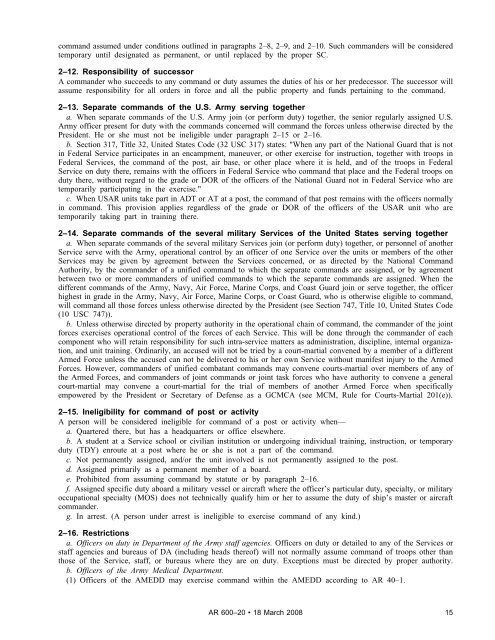AR 600-20, Army Command Policy - Army Publishing Directorate ...
AR 600-20, Army Command Policy - Army Publishing Directorate ...
AR 600-20, Army Command Policy - Army Publishing Directorate ...
You also want an ePaper? Increase the reach of your titles
YUMPU automatically turns print PDFs into web optimized ePapers that Google loves.
command assumed under conditions outlined in paragraphs 2–8, 2–9, and 2–10. Such commanders will be considered<br />
temporary until designated as permanent, or until replaced by the proper SC.<br />
2–12. Responsibility of successor<br />
A commander who succeeds to any command or duty assumes the duties of his or her predecessor. The successor will<br />
assume responsibility for all orders in force and all the public property and funds pertaining to the command.<br />
2–13. Separate commands of the U.S. <strong>Army</strong> serving together<br />
a. When separate commands of the U.S. <strong>Army</strong> join (or perform duty) together, the senior regularly assigned U.S.<br />
<strong>Army</strong> officer present for duty with the commands concerned will command the forces unless otherwise directed by the<br />
President. He or she must not be ineligible under paragraph 2–15 or 2–16.<br />
b. Section 317, Title 32, United States Code (32 USC 317) states: "When any part of the National Guard that is not<br />
in Federal Service participates in an encampment, maneuver, or other exercise for instruction, together with troops in<br />
Federal Services, the command of the post, air base, or other place where it is held, and of the troops in Federal<br />
Service on duty there, remains with the officers in Federal Service who command that place and the Federal troops on<br />
duty there, without regard to the grade or DOR of the officers of the National Guard not in Federal Service who are<br />
temporarily participating in the exercise."<br />
c. When US<strong>AR</strong> units take part in ADT or AT at a post, the command of that post remains with the officers normally<br />
in command. This provision applies regardless of the grade or DOR of the officers of the US<strong>AR</strong> unit who are<br />
temporarily taking part in training there.<br />
2–14. Separate commands of the several military Services of the United States serving together<br />
a. When separate commands of the several military Services join (or perform duty) together, or personnel of another<br />
Service serve with the <strong>Army</strong>, operational control by an officer of one Service over the units or members of the other<br />
Services may be given by agreement between the Services concerned, or as directed by the National <strong>Command</strong><br />
Authority, by the commander of a unified command to which the separate commands are assigned, or by agreement<br />
between two or more commanders of unified commands to which the separate commands are assigned. When the<br />
different commands of the <strong>Army</strong>, Navy, Air Force, Marine Corps, and Coast Guard join or serve together, the officer<br />
highest in grade in the <strong>Army</strong>, Navy, Air Force, Marine Corps, or Coast Guard, who is otherwise eligible to command,<br />
will command all those forces unless otherwise directed by the President (see Section 747, Title 10, United States Code<br />
(10 USC 747)).<br />
b. Unless otherwise directed by property authority in the operational chain of command, the commander of the joint<br />
forces exercises operational control of the forces of each Service. This will be done through the commander of each<br />
component who will retain responsibility for such intra-service matters as administration, discipline, internal organization,<br />
and unit training. Ordinarily, an accused will not be tried by a court-martial convened by a member of a different<br />
Armed Force unless the accused can not be delivered to his or her own Service without manifest injury to the Armed<br />
Forces. However, commanders of unified combatant commands may convene courts-martial over members of any of<br />
the Armed Forces, and commanders of joint commands or joint task forces who have authority to convene a general<br />
court-martial may convene a court-martial for the trial of members of another Armed Force when specifically<br />
empowered by the President or Secretary of Defense as a GCMCA (see MCM, Rule for Courts-Martial <strong>20</strong>1(e)).<br />
2–15. Ineligibility for command of post or activity<br />
A person will be considered ineligible for command of a post or activity when—<br />
a. Quartered there, but has a headquarters or office elsewhere.<br />
b. A student at a Service school or civilian institution or undergoing individual training, instruction, or temporary<br />
duty (TDY) enroute at a post where he or she is not a part of the command.<br />
c. Not permanently assigned, and/or the unit involved is not permanently assigned to the post.<br />
d. Assigned primarily as a permanent member of a board.<br />
e. Prohibited from assuming command by statute or by paragraph 2–16.<br />
f. Assigned specific duty aboard a military vessel or aircraft where the officer’s particular duty, specialty, or military<br />
occupational specialty (MOS) does not technically qualify him or her to assume the duty of ship’s master or aircraft<br />
commander.<br />
g. In arrest. (A person under arrest is ineligible to exercise command of any kind.)<br />
2–16. Restrictions<br />
a. Officers on duty in Department of the <strong>Army</strong> staff agencies. Officers on duty or detailed to any of the Services or<br />
staff agencies and bureaus of DA (including heads thereof) will not normally assume command of troops other than<br />
those of the Service, staff, or bureaus where they are on duty. Exceptions must be directed by proper authority.<br />
b. Officers of the <strong>Army</strong> Medical Department.<br />
(1) Officers of the AMEDD may exercise command within the AMEDD according to <strong>AR</strong> 40–1.<br />
<strong>AR</strong> <strong>600</strong>–<strong>20</strong> 18 March <strong>20</strong>08<br />
15
















